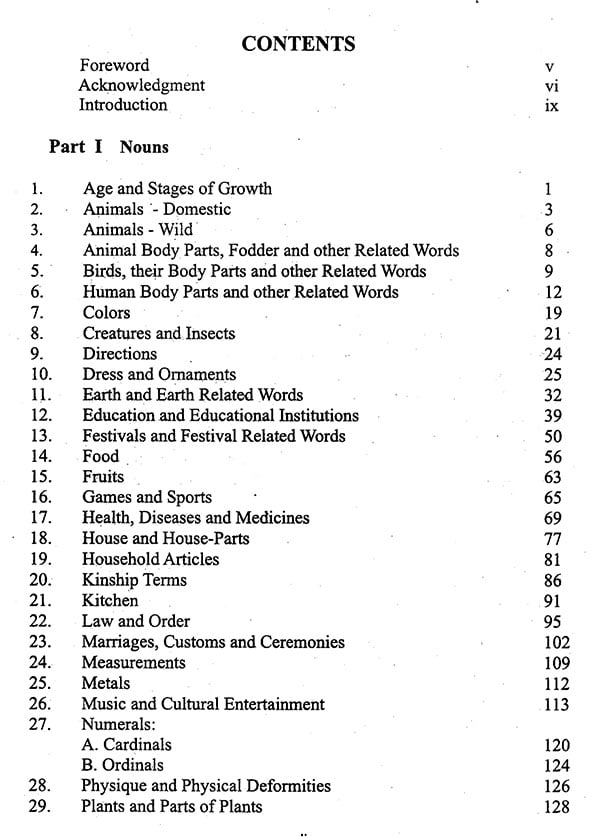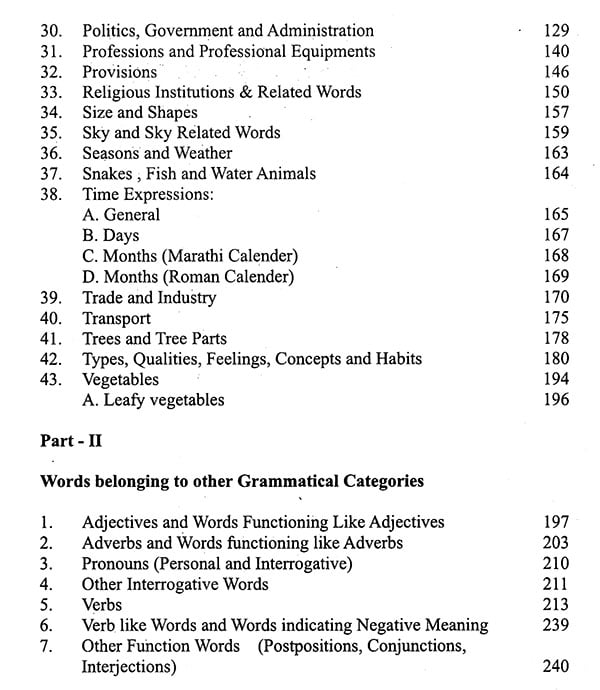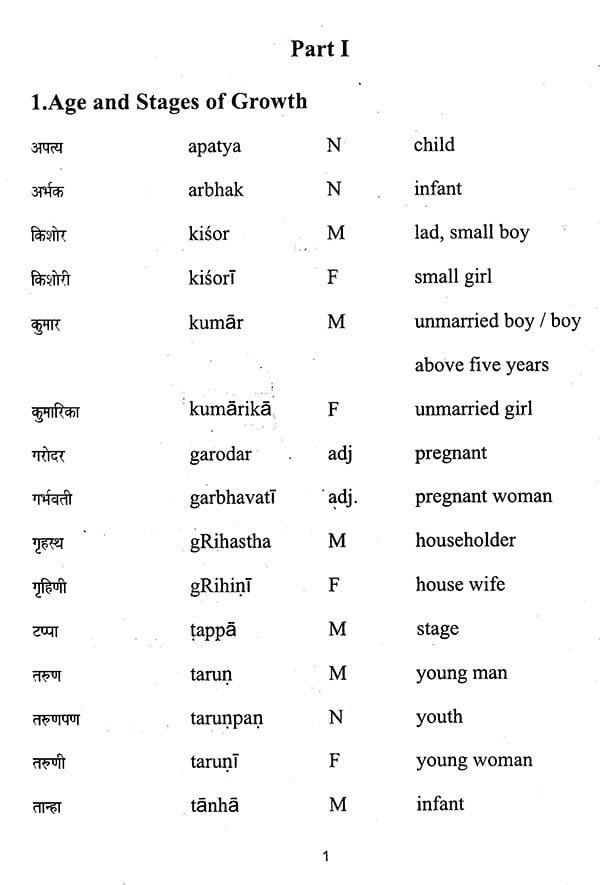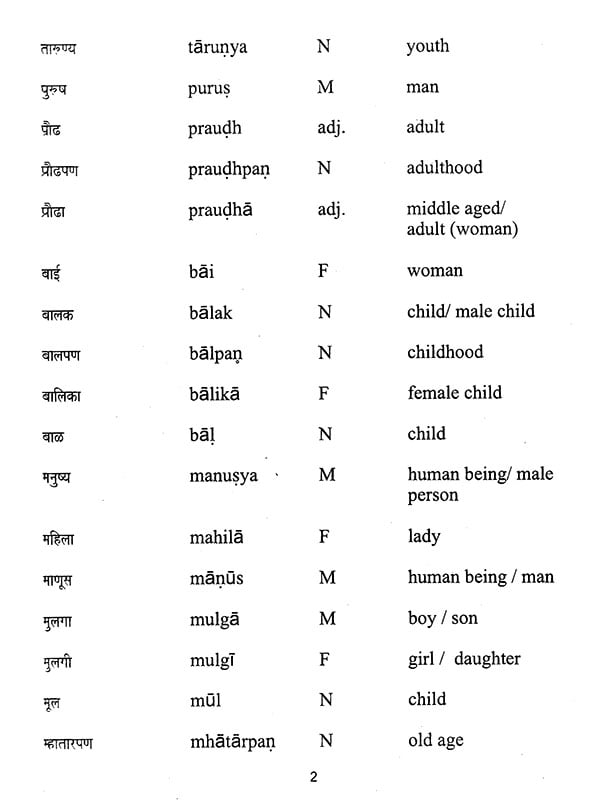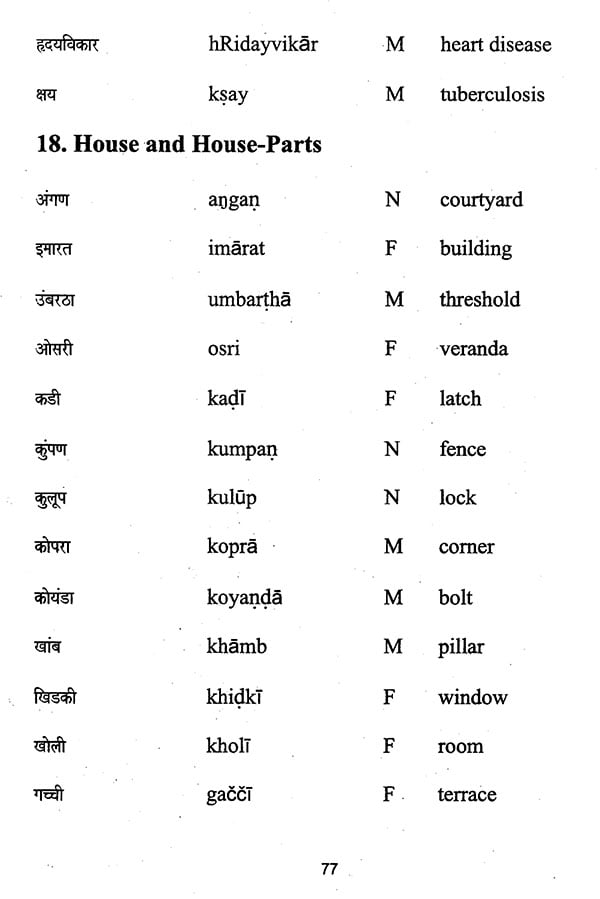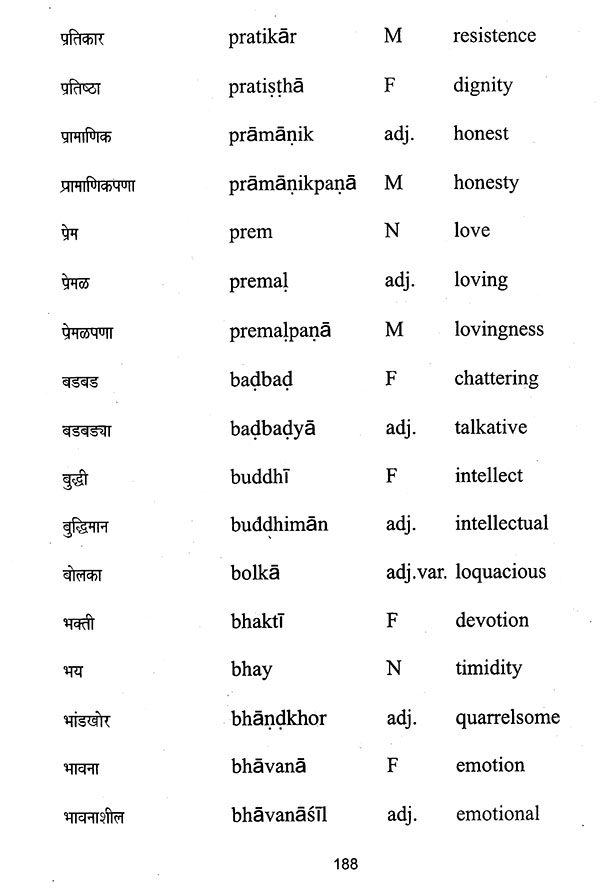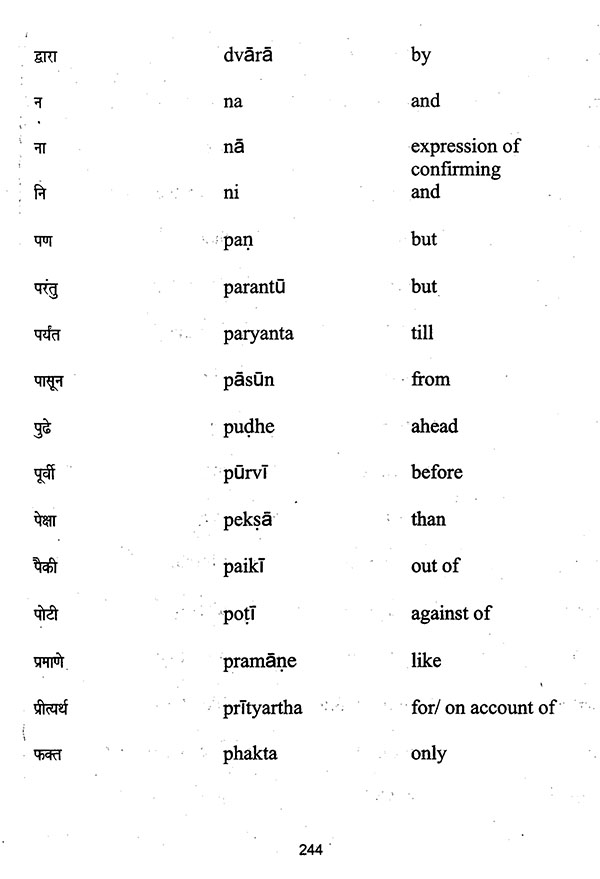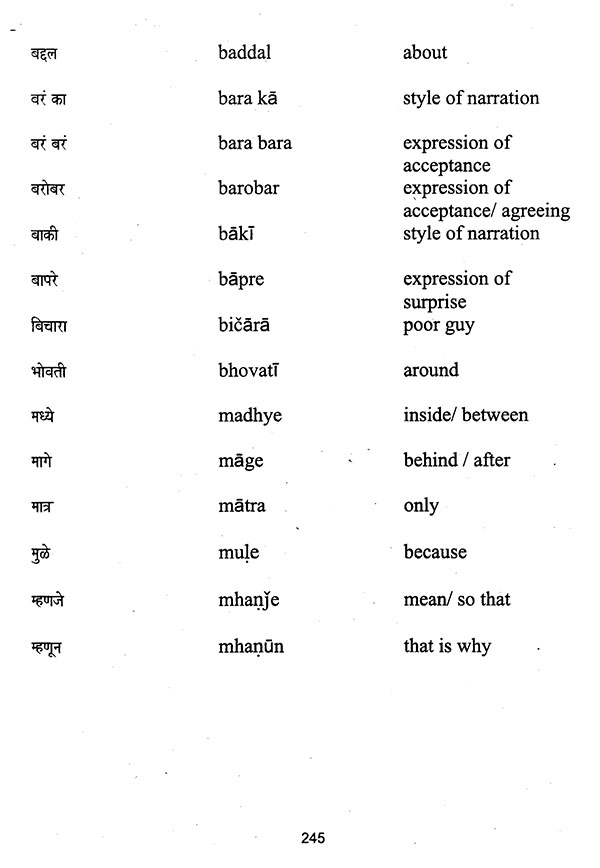
Classified Recall Vocabulary in Marathi
Book Specification
| Item Code: | MZO371 |
| Author: | Kalika Mehta |
| Publisher: | Central Institute Of Indian Languages, Mysore |
| Language: | Marathi and English |
| Edition: | 2012 |
| ISBN: | 9788173431173 |
| Pages: | 246 |
| Cover: | PAPERBACK |
| Other Details | 10.00 X 7.00 inch |
| Weight | 420 gm |
Book Description
One of the major tasks of CIIL which is entrusted with the responsibility of developing Indian languages through research, training and material production is to improve the teaching of Indian Languages in schools both as first and second language. This responsibility is executed also by the teaching of Indian languages as second language, through seven Regional Language Centers of the Institute.
Basic research plays an important role in developing and improving instructional materials, teaching methods and techniques, teacher training and the use of media. This basic research, which forms part of the activities of the Institute, has led to the development of innovative techniques for instruction and material production.
It is a well known fact that the Indian Languages lack empirical studies on vocabulary. Teaching of vocabulary is an integral part of teaching a language in any situation. Usually language courses present the use of vocabulary in context. There is a need to provide certain supplementary materials including lists of lexical items, glossaries, vocabularies and dictionaries in the target language. With these, preparation of instructional materials and teaching / learning the languages will be more meaningful.
The Institute tries to fill in these gaps through its publications such as Hindi- Regional Languages common vocabulary series, Basic vocabulary lists, Proficiency test series, Simplification of vocabulary of primary school textbooks, Pictorial glossaries, Bi and tri lingual dictionaries, verb dictionaries, etc. The present series of Semantically Classified Recall Vocabulary is an addition to the study of vocabulary.
This series of Recall vocabulary gives a list of words recalled by the authors of these series of publications which form part of the active vocabulary of a native speaker and hence it is expected that the users of this vocabulary list would find it useful to construct their own active vocabulary stock and the material producers would find it a boon while preparing materials for teaching/learning Marathi as second/foreign language. It must also be remembered here that studies on vocabulary also show that an adult learner recalls/associates words which are predominantly of the same parts of speech ata time. It is also hoped that when the Recall Vocabularies in other Indian Languages are published, one could make a comparison of them to find out what is common between the lists. This would establish a common cultural and cognitive base for the speakers of Indian languages.
A Semantically Classified Recall Vocabulary in Marathi is a guide to some ways in which vocabulary development is facilitated. It is hoped that the learners of Marathi will find this book useful.
The acquisition of vocabulary in any language both by the native and non-native speakers continues all through their life span. Not all the vocabulary items are acquired with the same rate nor are they retained with the same strength. The vocabulary items enter in the language of an individual at their own pace and occupy their place in his/her vocabulary stock. The total vocabulary of a living language also keeps on changing either by addition of new words or new meanings to the existing words or by deletion of certain words or meanings of the words. Also the vocabulary composition of one language varies from that of another language. The vocabulary availability in an individual speaker depends upon his/her experience and exposure to the language, educational background, socioeconomic group to which he/she belongs, the dialect he/she speaks, I.Q., sex, etc. The quantum and range of the vocabulary acquired in a language and the quality of their use are certainly a mark of the level of attainments in that language.
The importance of learning/teaching vocabulary in learning/teaching a language cannot be exaggerated. Good vocabulary and good reading go hand in hand. It is difficult to comprehend fully a sentence unless one knows the meaning(s) of words in that sentence. As the learners advance in concept development their vocabulary development must also correspondingly advance because the two are interrelated. Also possessing a good number of vocabulary items is especially important for the development of all the four skills of language, namely, listening, speaking, reading and writing. Learners who do not have competence in using vocabulary will usually lack competence In the production skills also. We should also recognize the fact that generally learners' listening and reading vocabulary- passive vocabulary- is larger than their speaking and wniting vocabulary-active vocabulary.
In this context, a list of Semantically Classified Vocabulary will be of great interest and use to the learners. This semantically classified vocabulary in Marathi is presented here as an aid to further develop the vocabulary potential of the learners of Marathi as a second/foreign language. This book is based on an assumption that words are not learnt mechanically as little pockets of meaning, but are learnt also through associations.
The Recall Process
This compilation Classified Recall Vocabulary in Marathi is prepared by a native speaker of Marathi. As far as recalling of the vocabulary is concerned, the process of recalling was spread over a period of six weeks. The words were recalled under different >road semantic groups such as man, plants, animals - both domestic and wild, birds, 2ducation and educational institutions, food, house and house parts. Within each broad group several sub-groups were identified thus arriving at 43 semantic subgroups for the category of nouns and 7 grammatical types for the rest. It may be noted here that the recalling process might have been affected by variables such as educational qualification, sex and experience in a particular field.
This book consists of two parts. Part I contains 3108 nouns, Part II contains 775 words such as adjectives, adverbs, verbs, pronouns, interrogative words and other function words such as post positions, interyections. Most of the words listed under a subgroup were recalled at one sitting. However, in some cases, while recalling the words belonging to a particular semantic subgroup, words of other groups also came to be recalled naturally due to some association or the other. These words were then and there recorded and later assigned to their appropriate groups. The semantic subgroups in this vocabulary list are so chosen as to include vocabulary items relating to familiar objects and day-to-day experiences. No dictionary or written record was used for collecting the materials.
In the recall of the vocabulary items, there was no specific attempt made to recall or restrict the words as belonging to spoken language or written language or those belonging to a particular dialect or register. All words that came to be recalled in the given particular context were recorded. As a result, this Recall Vocabulary reveals certain characteristic features as detailed in the next section.
Characteristics of Vocabulary Recalled
- Here are words from both spoken and written Marathi ranging from the very informal to the formal in both the planes.
- Another feature of the result of the recall was that the vocabulary items recalled, indeed, reflect all the ongoing trends in lexical choice, coinage and use. Words of current usage, words found in newspaper are all found recalled. Technical terms that are not fully in vogue but are sought to be replaced are also recalled, thus indicating that sometimes the trends in the language are of a conflicting nature.
- The list also consists of many words that are synonymous and found within the same semantic category.
- Some of the words were recalled in more than one category, reflecting the nature, role and function of such recalled items under various semantic categories.
- Yet another feature of the recalled items is the influence of cultural items under several semantic categories. Many words reflecting the cultural items have been recalled. While many of these cultural-specific words are in actual use, several others reflect only the infrequent and rare remnants.
- Many words of English and Sanskrit origin have also been recalled as falling within Marathi Vocabulary.
Arrangement and Presentation of Vocabulary Recalled
The arrangement and presentation of words under different subgroups are done according to the Marathi alphabetical order. But the groups themselves are arranged and presented on the basis of their labels following the English alphabet order for easy reference.
The vocabulary items are presented in this book in three columns. First column gives the words in Marathi in Devanagari script. The second presents them in Roman transliteration. The equivalents of Roman letters for individual Marathi letter are given in the chart appended to this introduction. The third column gives the English gloss for each entry. The gloss, however, does not indicate all the meanings of the given Marathi entry but gives the most frequently used ones.
Nouns in Marathi language are Masculine, Feminine or Neuter. They are grammatical genders. So the genders of the nouns are given after the entry of each noun. It may also be noted that like regular dictionaries, the entry of the verbs are given in verbal noun form. whereas, the root form of the verb is (non-polite i.e. second person singular imperative form) Appropriate suffix for the verb is added to this root form of the verb.
Though the domains of color, size, shapes, qualities etc. come under the section of Nouns, there are some adjectives which semantically come under these domains. Hence, it is specifically mentioned after the entry if it is an adjective and whether it varies according to the gender and number. Similarly, some verbs also had to be included under some domains in the section of Nouns. They are also specifically mentioned after the entry word.
This book is thus a supplementary material for the first/second language learners of Marathi. It can also be innovatively used by material producers as an additional tool to choose appropriate vocabulary for preparing different kinds of instructional and testing materials.
